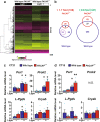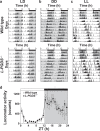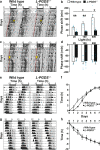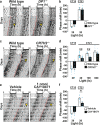Lipocalin-type prostaglandin D synthase regulates light-induced phase advance of the central circadian rhythm in mice
- PMID: 33033338
- PMCID: PMC7544906
- DOI: 10.1038/s42003-020-01281-w
Lipocalin-type prostaglandin D synthase regulates light-induced phase advance of the central circadian rhythm in mice
Abstract
We previously showed that mice lacking pituitary adenylate cyclase-activating polypeptide (PACAP) exhibit attenuated light-induced phase shift. To explore the underlying mechanisms, we performed gene expression analysis of laser capture microdissected suprachiasmatic nuclei (SCNs) and found that lipocalin-type prostaglandin (PG) D synthase (L-PGDS) is involved in the impaired response to light stimulation in the late subjective night in PACAP-deficient mice. L-PGDS-deficient mice also showed impaired light-induced phase advance, but normal phase delay and nonvisual light responses. Then, we examined the receptors involved in the response and observed that mice deficient for type 2 PGD2 receptor DP2/CRTH2 (chemoattractant receptor homologous molecule expressed on Th2 cells) show impaired light-induced phase advance. Concordant results were observed using the selective DP2/CRTH2 antagonist CAY10471. These results indicate that L-PGDS is involved in a mechanism of light-induced phase advance via DP2/CRTH2 signaling.
Conflict of interest statement
The authors declare no competing interests.
Figures





Similar articles
-
Changes in light-induced phase shift of circadian rhythm in mice lacking PACAP.Biochem Biophys Res Commun. 2003 Oct 10;310(1):169-75. doi: 10.1016/j.bbrc.2003.09.004. Biochem Biophys Res Commun. 2003. PMID: 14511666
-
Pituitary adenylate cyclase-activating polypeptide induces period1 and period2 gene expression in the rat suprachiasmatic nucleus during late night.Neuroscience. 2001;103(2):433-41. doi: 10.1016/s0306-4522(00)00563-7. Neuroscience. 2001. PMID: 11246158
-
Pituitary adenylate cyclase-activating polypeptide produces a phase shift associated with induction of mPer expression in the mouse suprachiasmatic nucleus.Neuroscience. 2002;113(1):37-45. doi: 10.1016/s0306-4522(02)00148-3. Neuroscience. 2002. PMID: 12123682
-
An essential role for peptidergic signalling in the control of circadian rhythms in the suprachiasmatic nuclei.J Neuroendocrinol. 2003 Apr;15(4):335-8. doi: 10.1046/j.1365-2826.2003.01005.x. J Neuroendocrinol. 2003. PMID: 12622830 Review.
-
Lipocalin-type and hematopoietic prostaglandin D synthases as a novel example of functional convergence.Prostaglandins Other Lipid Mediat. 2002 Aug;68-69:375-82. doi: 10.1016/s0090-6980(02)00042-4. Prostaglandins Other Lipid Mediat. 2002. PMID: 12432930 Review.
Cited by
-
Biochemical and Structural Characteristics, Gene Regulation, Physiological, Pathological and Clinical Features of Lipocalin-Type Prostaglandin D2 Synthase as a Multifunctional Lipocalin.Front Physiol. 2021 Oct 22;12:718002. doi: 10.3389/fphys.2021.718002. eCollection 2021. Front Physiol. 2021. PMID: 34744762 Free PMC article. Review.
-
In vitro heterochronic parabiosis identifies pigment epithelium-derived factor as a systemic mediator of rejuvenation by young blood.bioRxiv [Preprint]. 2024 May 5:2024.05.02.592258. doi: 10.1101/2024.05.02.592258. bioRxiv. 2024. PMID: 38746475 Free PMC article. Preprint.
-
Prostaglandin F2α Affects the Cycle of Clock Gene Expression and Mouse Behavior.Int J Mol Sci. 2024 Feb 2;25(3):1841. doi: 10.3390/ijms25031841. Int J Mol Sci. 2024. PMID: 38339119 Free PMC article.
-
PACAP-PAC1 Signaling Regulates Serotonin 2A Receptor Internalization.Front Endocrinol (Lausanne). 2021 Oct 25;12:732456. doi: 10.3389/fendo.2021.732456. eCollection 2021. Front Endocrinol (Lausanne). 2021. PMID: 34759890 Free PMC article.
-
Gpr19 is a circadian clock-controlled orphan GPCR with a role in modulating free-running period and light resetting capacity of the circadian clock.Sci Rep. 2021 Nov 17;11(1):22406. doi: 10.1038/s41598-021-01764-8. Sci Rep. 2021. PMID: 34789778 Free PMC article.
References
Publication types
MeSH terms
Substances
LinkOut - more resources
Full Text Sources
Molecular Biology Databases
Miscellaneous

